Sinharaja Rain Forest (UNESCO World Heritage Site) | Deniyaya, Sri Lanka
Sinharaja Rain Forest (UNESCO World Heritage Site)
"Immerse in Nature and Natural Beauty with Great Trekking, Unspoiled Beauty"
|
|
| Source: TripAdvisor |
Image Gallery

|

|

|
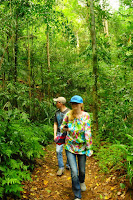
|
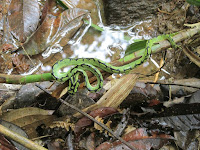
|

|
(Photo credits goes to original authors)
Directions (Google Maps)
Description
The Sinharaja (Lion King) rain forests occupy a broad ridge at the heart of the island’s wet zone. The only way to get about the reserve is by foot, and excellent park rangers (at the park entrance) or freelance guides (available through local hotels) can lead you along slippery trails, pointing out the wealth of stunning plant, bird and animal life. Entrance tickets are sold at the main Forest Department office at Kudawa and at Deodawa, 5KM from Deniyaya on the Matara road.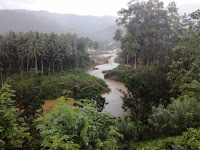 |
| Rivers among the Sinharaja Rain Forest |
balance water resources for much of southwestern Sri Lanka. Recognizing its importance to the Island’s ecosystem, UNESCO declared the Sinharaja Forest Reserve a World Heritage Site in 1989.
Sinharaja is bordered by rivers: the Koskulana Ganga in the north and the Gin Ganga in the south.
An old foot track that goes past the Beverley Estate marks the eastern border, close to the highest peak in the forest, Hinipitigala (1171M). Towards the west the land decreases in elevation.
The reserve comprises 189 Square KM of primary and modified forest, measuring about 21KM east to west and 3.7KM north to south. It was once a royal reserve, and some colonial records refer to it as Rajasinghe Forest. It may have been the last redoubt of the Sri Lankan lion.
Reaching Sinharaja Rain Forest
From Northern or western parts of the country you can reach Sinharaja Forest Reserve via Ratnapura, Kiriella, Kalawana, Weddala. From the South you can enter Sinharaja Rain Forest from Deniyaya. Coming form Hambantota, Udawalawe you can enter Sinharaja from Rakwana side.Area of Sinharaja Rain Forest
The total area of the Sinharaja Forest Reserve is 18,900 acres or 7,648 hectares. It ranges in altitude from 300M to 1,170M.Significance of Sinharaja Forest
Sinharaja Forest reserve is also home to over 50% of Sri Lanka’s endemic species of mammals and butterflies, as well as many kinds of insects, reptiles and rare amphibians.Establishment of Sinharaja Forest Reserve
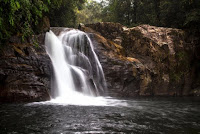 |
| Waterfalls in Sinharaja Rain Forest |
Climate of Sinharaja Rain Forest
Meteorological records gathered from in and around Sinharaja over the last 60 years reveal the annual rainfall of Sinharaja Forest has ranged between 3614MM to 5006MM and temperatures from 19°C to 34°C. The high rainfall is owing to two monsoons: south-west monsoons during May-July and the north-east monsoons during November-January.Nature trails of Sinharaja Rain Forest
The two main nature trails of Sinharaja Rain Forest are those lead to the peak of Moulawella and the peak of Sinhagala. Both of these nature trails begins at Kudawa Conservation Centre (KCC) are equally enjoyable and enlightening. The forest is densely crowded with tall trees growing in close proximity, but winding trails make the trekking. Small streams of crystal-clear cool water, that is home to a variety of fish, toads and crabs, crisscross the trails. And the mixed species of birds are seen in the canopy of woods.Sinhagala Nature Trail
Trail head: Entrance to the protected area, Kudawa Conservation Center, Weddagala, Kalawana
Trail end: Sinhagala Peak
Length of the trail: 2.4KM
Rise in elevation gain along the trail: 300m at Trail Head: 473M at Trail End
Approximate time: 5-7 hours
Hiking Season: Best months are December to April
Mulawella Nature Trail
Trail head: Entrance to the protected area, Kudawa Conservation Center, Weddagala, Kalawana
Trail end: Mulawella Peak
Length of the trail: 2.4 KM
Rise in elevation along the trail: 457m at Trail Head to 758M at Trail End
Approximate time: 1-2 hours
Hiking Season: Best months are December to April
Birdlife in Sinharaja Rain Forest
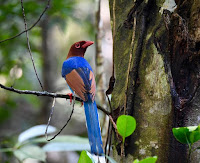 |
| Endemic Birds of Sri Lanka |
19 of Sri Lanka’s 20 species of endemic bird species in Sri Lanka are found in the Sinharaja Reserve
Among the endangered birds are Sri Lanka Wood Pigeon, Green-Billed Coucal, Sri Lankan white-headed starling, Red-faced Malkoha, Green-billed Caucal, Sri Lanka Spur fowl Sri Lankan Blue Magpie, and Ashy-headed Babbler, all of which are endemic.
Mammals, reptiles, amphibians and butterflies
Out of 12 endemic mammal species of the country 8 are found here. Giant squirrel, dusky-stripped jungle squirrel, badger mongoose and endemic purple-faced leaf monkey and torque macaque are frequently seen.Many threatened species of mammals, reptiles, amphibians and butterflies are found in the Reserve including the leopard. Endemism among mammals and butterflies is greater than 50%. Reptiles and amphibia include python, endemic green pit viper, endemic hump nosed lizard (Lyriocephalus scutatus) and and rough-nose horned lizard (Ceratophora aspera).
Conservation Value Sinharaja
Sinharaja Forest Reserve is the last viable remnant of Sri Lanka’s tropical lowland rain forest; over 60% of the trees are endemic and many of these are rare; and there are 21 endemic bird species, and a number of rare insects, reptiles and amphibians (IUCN Technical Evaluation).The long-term success of conserving Sinharaja depends upon the sustainable development of its buffer and peripheral zones through a participatory approach emphasizing the involvement of local people. Construction of hotels on peripheral zones and constructions of roads over the protected areas are bound to result in irrecoverable damages to this world heritage site.
Top sights in Sinharaja
Famous 7 waterfalls in Sinharaja Forest from Pitwala - Deniyaya EnteranceSinhagala Mountain
Duwili Ella
Kudawa Conservation Center
Things to remember in Sinharaja
Bring water bottle with appropriate clothing for rain forest trekking.• Clothing - Loose cotton or breathable fabric clothes. (watch out for leeches)
• Shoes - Good trainers/runners/ sneakers.
• Clothing - Loose cotton or breathable fabric clothes. (watch out for leeches)
• Ornaments - Natural remedies for leeches e.g. Soap, Lime, Salt
Hiking Season: Best months are December to April
Get entrance ticket and local guide (mandatory requirement 10 USD)
Places nearby
GalleMatara
Mirissa
Ahangama
Weligama
Kanneliya Rain Forest
Hotels nearby
Sinharaja Rain Forest View Villas
Jansen's bungalow Sinharaja
Sinharaja Hostel
Sinharaja Forest Edge
Explore Sinharaja Rain Forest Tour Camp
References:
https://lanka.com/about/attractions/sinharaja-rain-forest
https://www.lonelyplanet.com/sri-lanka/sinharaja-forest-reserve/attractions/sinharaja-forest-reserve/a/poi-sig/1195467/357480






Leave a Comment